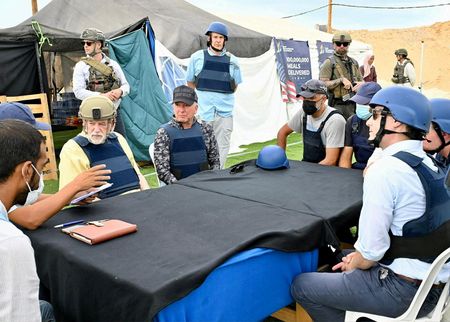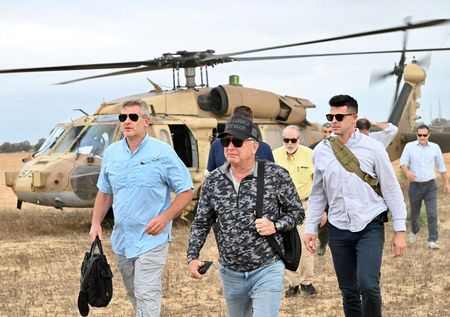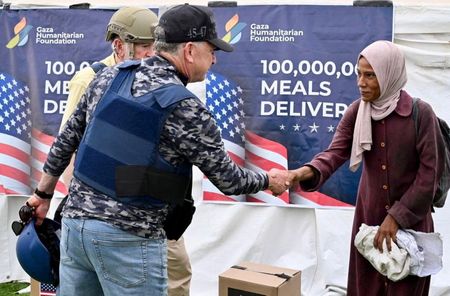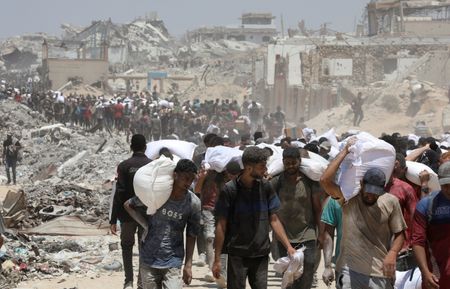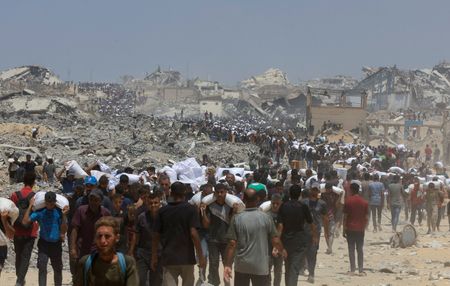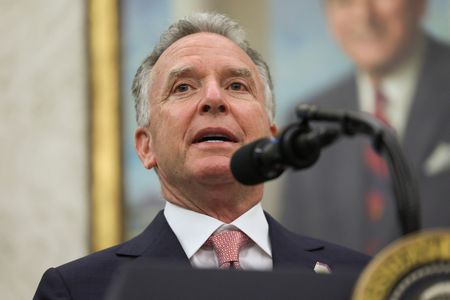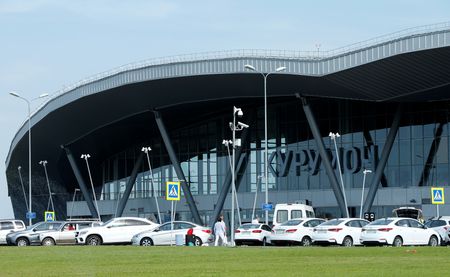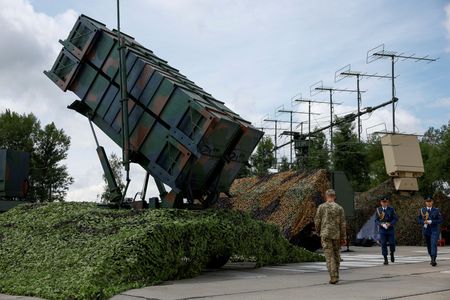By Nidal al-Mughrabi and Charlotte Greenfield
CAIRO/JERUSALEM (Reuters) -President Donald Trump’s Middle East envoy visited a U.S.-backed aid operation in Gaza on Friday, which the United Nations has partly blamed for deadly conditions in the enclave, saying he sought to get food and other aid to people there.
Steve Witkoff visited a site run by the U.S. and Israel-backed Gaza Humanitarian Foundation in Rafah in the war-shattered Palestinian territory, where Israel has been fighting the militant group Hamas.
Humanitarian organizations and many foreign governments have been strongly critical of the GHF, which began operations in late May. A global hunger monitor warned this week that famine is unfolding in Gaza.
Hours after Witkoff’s visit, Palestinian medics reported Israeli forces shot dead three Palestinians near one of the group’s sites in the city on Gaza’s southern edge. Reuters could not immediately verify whether it was the same location.
The Israeli military said it was still looking into the incident in which soldiers fired warning shots at what it described as a “gathering of suspects” approaching its troops, hundreds of metres from the aid site.
The United Nations says more than 1,000 people have been killed trying to receive aid in Gaza since the GHF began operating, most of them shot by Israeli forces operating near GHF sites.
The Israeli military has acknowledged that its forces have killed some Palestinians seeking aid and says it has given its troops new orders to improve their response.
The U.N. has declined to work with the GHF, which it says distributes aid in ways that are inherently dangerous and violate humanitarian neutrality principles, contributing to the hunger crisis across the territory.
The GHF says nobody has been killed at its distribution points, and that it is doing a better job of protecting aid deliveries than the U.N.
Israel blames Hamas and the U.N. for the failure of food to get to desperate Palestinians in Gaza and introduced the GHF distribution system, saying it would prevent aid supplies being seized by Hamas. Hamas denies stealing aid.
Indirect negotiations between the sides aimed at securing a 60-day ceasefire and hostage release deal ended last week in deadlock.
Hamas on Friday released a video of Israeli hostage Evyatar David in one of its tunnels appearing skeletally thin. Its allied Islamic Jihad militant group released a video on Thursday of hostage Rom Braslavski, crying and pleading for his release.
CRAFTING A PLAN
U.S. Ambassador to Israel Mike Huckabee, who traveled with Witkoff to Gaza on Friday, posted on X a picture showing hungry Gazans behind razor wire with a GHF poster displaying a big American flag and the words “100,000,000 meals delivered”.
“President Trump understands the stakes in Gaza and that feeding civilians, not Hamas, must be the priority,” GHF spokesperson Chapin Fay said in a statement accompanied by images of Witkoff in a grey camouflage top, flak jacket and “Make America Great Again” baseball cap with Trump’s name stitched on the back.
Witkoff said on X that he had also met with other agencies.
“The purpose of the visit was to give @POTUS (Trump) a clear understanding of the humanitarian situation and help craft a plan to deliver food and medical aid to the people of Gaza,” Witkoff said.
He visited Gaza a day after meeting Israeli Prime Minister Benjamin Netanyahu. Israel is under mounting international pressure over the devastation of Gaza since the start of the war and growing starvation among its 2.2 million inhabitants.
MALNUTRITION
Gaza medics say dozens have died of malnutrition in recent days after Israel cut off all supplies to the enclave for nearly three months from March-May.
Israel says it is taking steps to let in more aid, including pausing fighting for part of the day in some areas and announcing protected routes for aid convoys.
The worsening crisis has prompted France, Britain and Canada to announce plans to potentially recognise a Palestinian state, a move already taken by most countries but not by major Western powers.
On Friday, the Israeli military said that 200 trucks of aid were distributed by the U.N. and other organizations on Thursday, with hundreds more waiting to be picked up from the border crossings inside Gaza.
The United Nations says it has thousands of trucks still waiting, if Israel would let them in without the stringent security measures that aid groups say have prevented the entry of humanitarian assistance.
Israel began allowing food air drops this week, but U.N. agencies say these are a poor alternative to letting in more trucks. On Friday, the Israeli military said that 126 food packages were airdropped by six countries, including for the first time France, Spain, and Germany.
In addition to the fatalities near a GHF site, medics said 12 other Palestinians were killed in airstrikes in Gaza on Friday. The Israeli military did not immediately comment.
The Gaza war began when Hamas killed more than 1,200 people and took 251 hostage in an attack on southern Israel on October 7, 2023, according to Israeli figures. Israel’s offensive has since killed more than 60,000 Palestinians, according to Gaza health officials.
(Reporting by Nidal al-Mughrabi, Charlotte Greenfield and Maayan Lubell in Jerusalem, Olivia Le Poidevin and Ahmed ElimamEditing by Peter Graff, Mark Heinrich, Frances Kerry and Cynthia Osterman)

